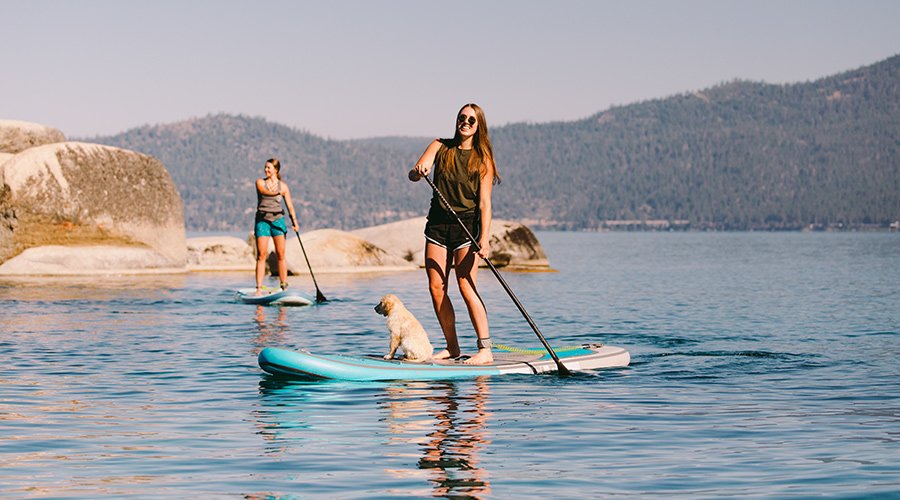
Paddleboarding is a great water activity to get into. It’s a great full-body workout and offers tons of fun. It is also very beginner-friendly and pretty easy to pick-up which also adds to it’s growing popularity worldwide.
But the amount of information out there can be overwhelming. That is why we made this guide to help you with your first foray into the sport. So before you head out to the nearest beach and start paddling away, here are a few tips to keep in mind.
Know your gear
It’s very tempting to just grab a board then head straight into the water and paddle away. But, as with any other sport, knowing and understanding your equipment is crucial. And with SUP having such a broad scope, the gear you use must be suited to your needs.
Pick a board that’s right for you
Picking your equipment is a crucial first step especially for beginners. If you’re wondering what type and size of paddle board is best for you, then are lots of things to consider but, for beginners, there are only two that are important: body type and activity. Your body type determines the dimensions of the paddle and board. The type of activity you plan on doing determines the shape and features of the board and paddle.
Learn equipment maintenance
Learning how to keep your gear in tip-top shape is also a very important skill to master early on. Good quality equipment is made to last long but they are only as good as how they are maintained. Knowing proper maintenance will greatly maximize the lifespan of your gear.
Get proper safety equipment
Though generally a very laidback and relaxed sport, just like any outdoor activity, there are still some risks involved. For beginners, having a life vest on is great to have even if you are confident with your swimming. You will fall off your board constantly and not having to use a lot of energy to stay afloat is a lifesaver.
Another important safety feature is a leash. As the name suggests, a leash attaches your board to you via a long piece of line. This lets you not lose your board in the event of a wipeout. Likewise, you can also use a leash on your paddle.
Proper safety equipment includes a life jacket/PFD for you (and your dog). It’s a requirement by the US Coast Guard!
Use proper technique
Now that’s out of the way, we can start paddling! As with any other sport, technique and execution are important to maximize your time paddleboarding.
Master the basics
First up is how to properly hold your paddle. To do this hold the paddle with both hands with one hand on the “T” section while the other is midway down the shaft. Then raise the paddle over your head adjusting your grip until both your arms form 90 degree angles at the elbows.
To stay balanced on the board, you have to stand at the center. Your feet should be shoulder-width apart and both pointing forward. Then, bend your knees slightly while keeping your back as straight as possible. This lowers your center of gravity as well as lets you easily adjust your balance. Now you are ready to paddle.
The key to not tiring quickly is to paddle with your core rather than your arms. Twist your body with every stroke and keep your arms firm yet relaxed. Your core muscles are much stronger than your arms and don’t tire out as quickly. In the water, the paddle blade should curve forward. This allows the paddle to be easily pushed with minimal energy.
Posture is everything
Good posture is the foundation of paddleboarding. This can be tricky for beginners because balancing while floating on water is quite a challenge
Getting on to your board can be tricky for newbies. The key is to not rush it but to do it in steps. Start by positioning your board in shallow water making sure that the fin does not touch the bottom. Then gently get on the board by using your two hands ending in a kneeling position. Then, slowly get up with one leg after the other.
Know how to be safe
Now that you can actually paddle about on the water, it’s easy to get caught up in the moment and paddle to your heart’s content. It’s all well and good if you are somewhere private but if you are in open water or a popular lake, chances are there will be others in the water too. Paddle boards, especially non-inflatable ones, are hard and they can hurt. Always be mindful of your surroundings and watch out for other people. Always stay clear from swimmers, boats, and other paddlers to keep yourself and others safe.
Know how to fall correctly
Falling off your board is part of the experience. Even seasoned SUP enthusiasts sometimes lose their balance and fall off. Because it is inevitable, knowing how to fall safely is something you should prepare. You would want to fall away from your board and with the paddle out of the way. This is why leashes are so important especially when the water is turbulent.
Know when NOT to paddle
As a beginner, it’s really tempting to head to the beach or lake to paddle all day long every chance you get. But some things can affect your experience and, in some cases, your safety. Always be smart about how and when you go paddle boarding. Check the weather before you head out.
Paddle with friends
Having a buddy with you when SUPing is great for newbies especially if they are more experienced. Not only is it fun to spend time with friends on the water. They can help coach you on your technique and help you master all the skills. Their years of experience can also be a real lifesaver in an emergency.
But the biggest reason to paddle with friends is that it is so much more fun! It’s a great bonding activity for friends and family turning an ordinary beach outing into something extra. Who wouldn’t want to spend a wonderful sunny day lazily paddling in the sea with their buddies?








